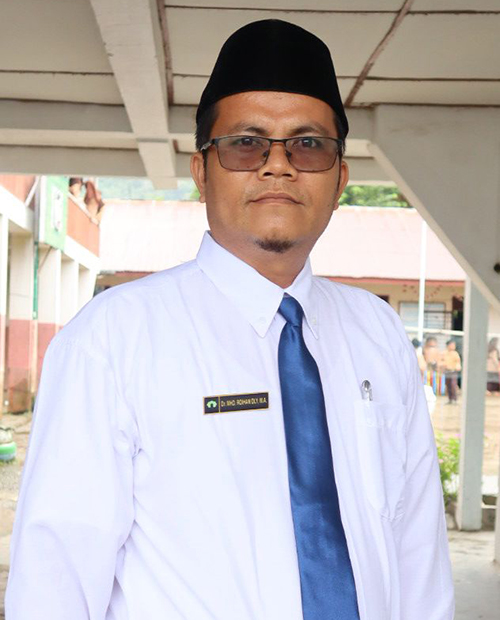Efforts to Improve Language Intelligence in Early Childhood through Letter Card Media at R.A. Manbaul Hikmah Luwungragi Bulakamba Brebes
Keywords:
Language intelligence, Letter card mediaAbstract
The purpose of this study is to improve language intelligence in early childhood through the use of letter card media at RA Manbaul Hikmah Luwungragi Bulakamba Brebes. This study uses data collection methods through observation, documentation, and interviews. The type of research used is Classroom Action Research (PTK) with two main variables, namely language intelligence as a bound variable and letter card media as an independent variable. The object of this research is all students of PAUD Group B RA Manbaul Hikmah Luwungragi Bulakamba Brebes in the even semester of the 2015/2016 school year. The number of students involved in this study was 12 children, consisting of 4 male students and 8 female students. The research process was carried out in two cycles, where each cycle consisted of three meetings. The data collection method in this study involves observation, interviews, and documentation to obtain accurate data on the development of children's language intelligence. The results of the study show that improving language intelligence through the medium of letter cards at RA Manbaul Hikmah Luwungragi Bulakamba Brebes is included in the very good category. After being given learning using letter card media for two cycles, there was a significant improvement in children's language intelligence. Some of the assessment indicators used in this study include good language skills, the ability to perform tasks well, and letter recognition through letter card media. The learning results in the first cycle showed an increase of 19%, while in the second cycle it increased to 56%. This shows that the use of letter card media can help students in significantly improving their language intelligence. Based on the findings above, some of the suggestions that can be given include teachers are expected to create an interesting and fun learning experience for RA Manbaul Hikmah students, as well as provide encouragement and guidance so that children feel comfortable learning. In addition, teachers are expected to develop similar learning models for every other subject and share experiences with other teachers. Follow-up for students who have not completed needs to be done with collaboration between teachers and researchers to provide more intensive motivation and guidance. In addition, it is recommended to provide more frequent activities that can improve language skills, such as the use of letter card media or other relevant methods.References
Ary, D., Jacobs, L. C., Sorensen, C., & Razavieh, A. (2018). Introduction to research in education (10th ed.). Cengage Learning.
Brown, H. D. (2007). Principles of language learning and teaching (5th ed.). Pearson Education.
Creswell, J. W. (2014). Research design: Qualitative, quantitative, and mixed methods approaches (4th ed.). SAGE Publications.
Daryanto, & Rahardjo, M. (2012). Media pembelajaran. Gava Media.
Gagne, R. M. (1985). The conditions of learning and theory of instruction (4th ed.). Holt, Rinehart, & Winston.
Harmer, J. (2007). The practice of English language teaching (4th ed.). Pearson Longman.
Hikmah, N. (2020). Peningkatan kecerdasan bahasa melalui media kartu huruf di RA. Jurnal Pendidikan Anak Usia Dini, 5(2), 120-135.
Iskandarwassid, & Sunendar, D. (2008). Strategi pembelajaran bahasa. Remaja Rosdakarya.
Jalal, F., & Supriadi, D. (2001). Reformasi pendidikan dalam konteks otonomi daerah. Adicita Karya Nusa.
Kamus Besar Bahasa Indonesia (KBBI). (2016). Edisi V. Badan Pengembangan dan Pembinaan Bahasa.
Moleong, L. J. (2019). Metodologi penelitian kualitatif (Revisi ed.). PT Remaja Rosdakarya.
Muijs, D. (2011). Doing quantitative research in education with SPSS (2nd ed.). SAGE Publications.
Nunan, D. (1999). Second language teaching & learning. Heinle & Heinle.
Piaget, J. (1962). Play, dreams and imitation in childhood. W.W. Norton & Company.
Richards, J. C., & Rodgers, T. S. (2014). Approaches and methods in language teaching (3rd ed.). Cambridge University Press.
Santrock, J. W. (2011). Child development (13th ed.). McGraw-Hill.
Slamet, S. (2008). Bermain sambil belajar di pendidikan anak usia dini. Universitas Terbuka.
Sugiyono. (2017). Metode penelitian pendidikan pendekatan kuantitatif, kualitatif, dan R&D. Alfabeta.
Vygotsky, L. S. (1978). Mind in society: The development of higher psychological processes. Harvard University Press.
Wibowo, A. (2012). Psikolinguistik: Teori dan penerapannya dalam pembelajaran bahasa. Pustaka Pelajar.
Downloads
Published
How to Cite
Issue
Section
License

This work is licensed under a Creative Commons Attribution-ShareAlike 4.0 International License.









